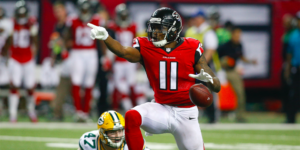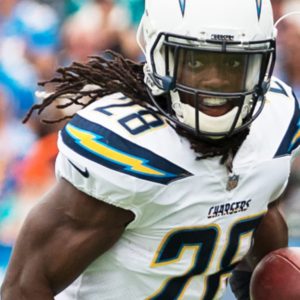Trade Strategy: Lesson Two
As we learned in lesson one, Fantasy football championships aren’t won on draft day. The construction of a winning roster is a full-season commitment and requires a lot of luck and skill. One of those skills is knowing how to put together a good trade and when to execute a deal. Trading can be intimidating–especially to the newer fantasy player. Learning to recognize opportunity and the tendencies of the other owners in your league will help to get more deals done.
The biggest intimidation factor of receiving an offer is “what does this owner know that I don’t?” Usually, nothing. The main reason to send an offer is simple: you want that player on your roster. Knowing why you want that player is the key to getting the right deals done. In redraft, you want to acquire players from a good offense,that are in line for a high-volume role. The best traders take advantage of dips in value that can come from a number of factors including a particular player is experiencing a fluky touchdown drought. You must also identify when to sell. That time comes when a player’s market value surpasses their actual value. An example of this is a hot streak that cannot be sustained, especially coming from touchdowns above expectation.
Touchdown Regression
What is fluky touchdown regression? This can be experienced both positive or negative. Either the player is not scoring the expected number of touchdowns based on opportunity (Julio Jones’ first half of 2018), or is scoring an extraordinary number of touchdowns at a rate that cannot be sustained (Melvin Gordon’s first half of 2018).
 Through the first eight weeks of the season, Jones scored just one touchdown on 91 targets. He had over 11 targets per game and only one touchdown to show for it. Gordon had a ridiculous nine touchdowns in the first eight weeks on 17 opportunities from inside the 10-yard line (rushes and targets combined). Half the time the Chargers got within 10 yards of the goal line, Gordon was able to get them in the end zone. He was on pace to flirt with the single-season record.
Through the first eight weeks of the season, Jones scored just one touchdown on 91 targets. He had over 11 targets per game and only one touchdown to show for it. Gordon had a ridiculous nine touchdowns in the first eight weeks on 17 opportunities from inside the 10-yard line (rushes and targets combined). Half the time the Chargers got within 10 yards of the goal line, Gordon was able to get them in the end zone. He was on pace to flirt with the single-season record.
In statistics, all things will eventually come back to the mean. Understanding the variance on either side can help you make a trade. Yes, football is a microscopic level when using statistics. Knowing the records and historical pace can help you determine if it’s a trend, an outlier, or something that won’t continue. Fantasy success is achieved by recognizing what’s most likely to happen.
Recognize and Exploit
If Gordon was on your roster, you weren’t shopping him unless you recognized how many touchdowns he was getting based on opportunity. Trading him for Jones would have been easy, as that owner was likely frustrated with the zero in his TD column. Even easier in retrospect, but both players have name recognition and are on quality offenses.
In the second half of the season, Gordon’s touchdowns tailed off with just five scores on 13 opportunities inside the 20-yard line). Jones started to go nuts, scoring touchdowns in just about every game with seven in the last eight games on 79 targets, 19 fewer than in the first half of the season when he was allergic to the end zone.
Changes in Value
Trading for Jones during the second half of the season would have been tough. Savvy fantasy gamers would have traded for him during the touchdown drought. But there was still a window of opportunity once he finally go into the end zone. In the micro-scale of a redraft season, a two game performance spike of about the same production typically means that player has turned a corner. The owner may not believe, so you should throw an offer out to check. Not every owner will believe that two game spike will continue and will attribute it to the matchup or another factor. The owner that doesn’t believe will think they’re selling high.
Touchdown Opportunity
A name-value player on a bad offense (LeSean McCoy for example) is not worth the same as a lower tiered player on a good to great offense, (James White). The good offenses will continue to put players in position to gain touches, score touchdowns, and rack up yards. A bad offense can lead to lower volume and fewer touchdown opportunities. The goal of fantasy football is to score points, and nothing scores more points than touchdowns.

Owner Recognition
Knowing the philosophies and strategies of your leaguemates is incredibly important when seeking out buy/sell opportunities. Group chats and tracking draft and waiver pick-up strategies are great ways to understand the mind of your competitors. Risk adverse owners will avoid players with checkered injury histories and off the field red flags. They prefer the high floor, safe players. If a player starts to pop up on the injury report for multiple weeks, but plays through it, toss an offer that owner’s way. Odds are they are concerned The risk-taking owner will seek out the high-upside plays despite their lower floor. Any lowered tier player that explodes, try and sell to this owner. Chances are they’ll buy the narrative and go for it.
What kind of offers should you send?
Take advantage of fluctuations in the market, and recognize when a player is producing below or above expectation. Don’t worry about always having to “win” the deal. Fair trades are okay too. Making deals that help both sides create a good trading relationship with your leaguemates. Sometimes the best deals don’t look like wins on paper. A trade that you feel good about is the best sign of a good deal.





